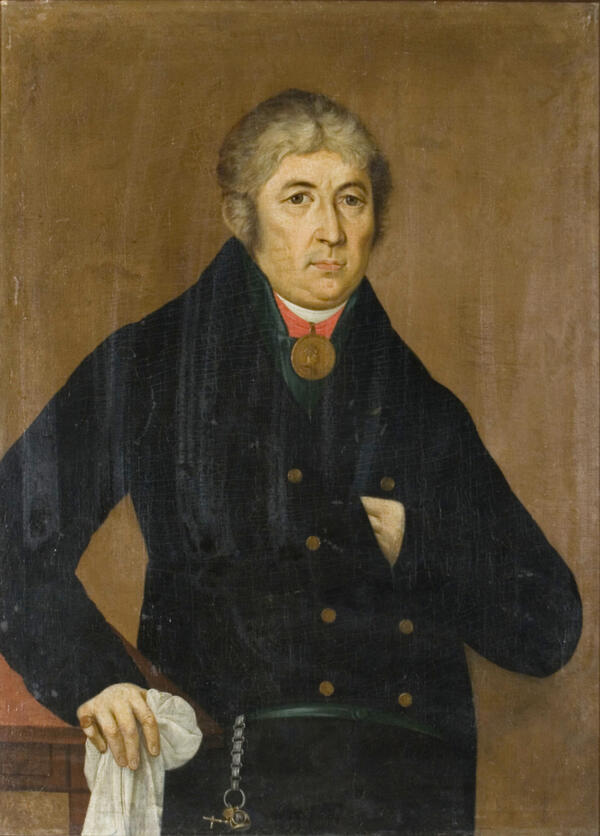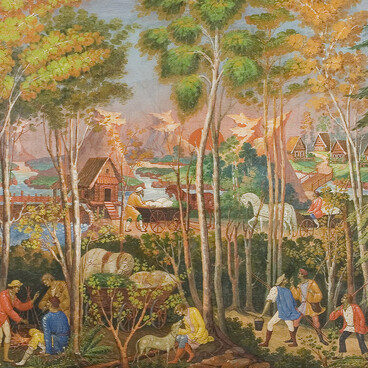In 1945, portraits of Yakut merchants created by local painters and previously kept in the Yakut Museum of Local Lore were added to the National Art Museum’s collection of Russian art. Travelers who found themselves on the outskirts of the Russian Empire always noted with surprise in their written testimonies that there were skilled craftsmen in Yakutsk who depicted famous citizens and painted numerous churches and cathedrals.
The “Portrait of the Yakut Merchant Solovyov” by an unknown artist of the early 19th century is an example of fine art which was based on techniques mastered by Russian artists in the early 18th century and preserved in the Russian province for quite a long time, until the early 19th century. This is also expressed in the manner with which portraits were painted: they bore resemblance to the parsuna, an early genre of portrait, with its closed composition, materialism and static poses. Such portraits required the highest skill, both in achieving likeness and in depicting textures and telling details — attributes of the merchant class. This is demonstrated by the paired portraits: the “Portrait of the Yakut Merchant Solovyov” and the “Portrait of a Merchant’s Wife”. The unknown artist brilliantly works with color, perfectly conveys the patterns on fabric, and is attentive to details. The researcher Elena Bannikova notes that “the peculiarity of the merchant’s costume was not that the merchants wore some special things that no one else wore, but rather in the way they combined pieces. Some of them were borrowed from the attire of ‘masters’ [landowners], others were of peasant origin, but differed from their folk versions in better quality and higher price.”
Judging by the monogram on the ring with the initials VAS, the artist portrayed the famous Yakut merchant Vasily Afanasievich Solovyov, born in 1769. He wears a gold medal “For Diligence” on the neck ribbon of St. Anna. Such medals were awarded to merchants, peasants and burghers for various services rendered to the government. The merchants Solovyovs were known for their charitable contributions, patronages, and construction activities. The five-domed Orthodox Cathedral of the Transfiguration of the Savior and a tented bell tower next to it were built on donations from the Solovyov family.
The “Portrait of the Yakut Merchant Solovyov” by an unknown artist of the early 19th century is an example of fine art which was based on techniques mastered by Russian artists in the early 18th century and preserved in the Russian province for quite a long time, until the early 19th century. This is also expressed in the manner with which portraits were painted: they bore resemblance to the parsuna, an early genre of portrait, with its closed composition, materialism and static poses. Such portraits required the highest skill, both in achieving likeness and in depicting textures and telling details — attributes of the merchant class. This is demonstrated by the paired portraits: the “Portrait of the Yakut Merchant Solovyov” and the “Portrait of a Merchant’s Wife”. The unknown artist brilliantly works with color, perfectly conveys the patterns on fabric, and is attentive to details. The researcher Elena Bannikova notes that “the peculiarity of the merchant’s costume was not that the merchants wore some special things that no one else wore, but rather in the way they combined pieces. Some of them were borrowed from the attire of ‘masters’ [landowners], others were of peasant origin, but differed from their folk versions in better quality and higher price.”
Judging by the monogram on the ring with the initials VAS, the artist portrayed the famous Yakut merchant Vasily Afanasievich Solovyov, born in 1769. He wears a gold medal “For Diligence” on the neck ribbon of St. Anna. Such medals were awarded to merchants, peasants and burghers for various services rendered to the government. The merchants Solovyovs were known for their charitable contributions, patronages, and construction activities. The five-domed Orthodox Cathedral of the Transfiguration of the Savior and a tented bell tower next to it were built on donations from the Solovyov family.




